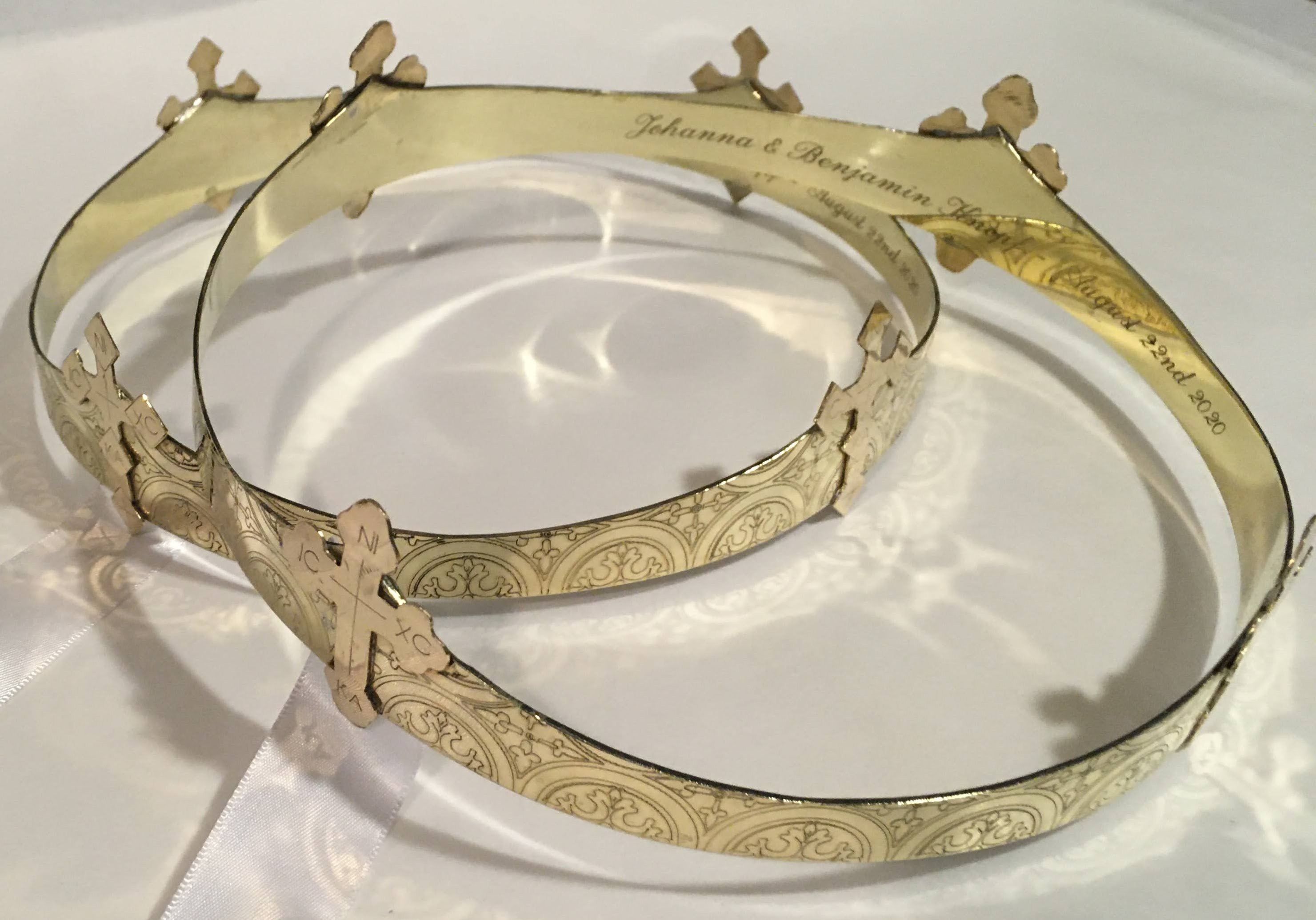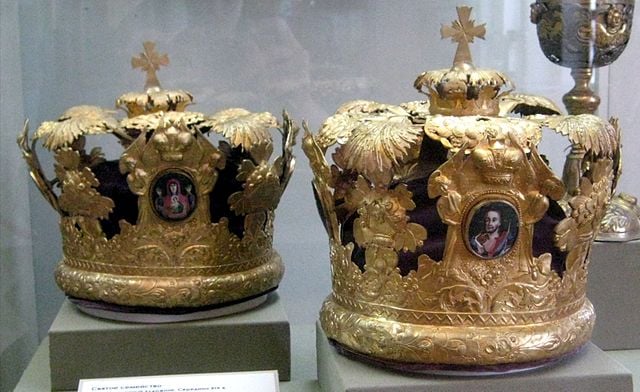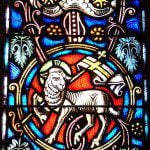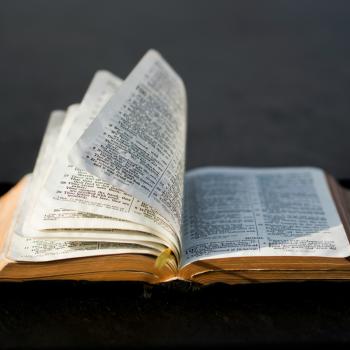
“Religion Behind the Scenes” spotlights the less discussed, but no less crucial, tasks that keep religious communities running, and the people who make it all happen.
Marriage is sacramental in almost every religion—Christian and non-Christian alike. Eastern Orthodoxy, the second largest Christian tradition, is no different. Holy matrimony is one of the seven sacraments of the Church and, perhaps, one of the most important and influential of the sacraments; so much so that, unlike in the Roman Catholic tradition, in Eastern Orthodoxy, even parish priests are expected to be married.
One aspect of the sacrament of marriage that sets the Eastern Orthodox tradition apart from all other Christian denominations is their use of “Stefana” or “Wedding Crowns”—a powerful and important symbol in their marital rites. As the Orthodox priest, Father Thomas Hopko, pointed out, in the Eastern Orthodox marriage rite, “what is begun on earth does not ‘part in death’ but is fulfilled and continues most perfectly in the Kingdom of God.” These wedding crowns, so central to the marriage ceremony, symbolize and emphasize that important doctrine of Eastern Orthodoxy.
In this installment of Religion Behind the Scenes, we talk with Ann Clough, the founder of . Ann has spent nearly two decades now designing and creating wedding crowns for Orthodox couples participating in the sacrament of holy matrimony. In our conversation, Ann and I discussed the making of these crowns, the sacred symbolism associated with them, and how this work has influenced her spiritually.
So, since you make wedding crowns for the Eastern Orthodox tradition, I'm assuming you're an Orthodox Christian. Am I correct about that?
Yes. My dad's family is from Syria and Lebanon. My maiden name is Corey and in Levantine Arabic “Khouri” means “priest.” And in every generation of my family, there’s been a priest. I’m a practicing Antiochian Orthodox.
Most of our readers will not be practitioners of Eastern Orthodoxy, so perhaps we could start by you telling us a bit about what wedding crowns are.
Well, marriage is one of the seven sacraments of the Orthodox Church, and the bride and groom (at their wedding) will wear a “crown” during the ceremony. The “crowning ceremony” plays an integral role in the Orthodox wedding rite, and crowns have been part of that sacrament in our tradition for as long as anyone can remember.
What’s the symbolism behind these crowns?
As with all other things in the Orthodox Church, there are layers of symbolism when it comes to the crowns. I really liked by Father Anthony Yazge:
“We witness the groom and bride being crowned (visibly proclaimed) as the king and queen, respectively, of a new family, entrusted by God with the authority to rule their family in faith and love and harmony with Christ. They both share in this responsibility and privilege as a newly married couple. This is not simply being declared by the priest or even the Church, but by God Himself, as the following hymn is chanted three times: ‘O Lord, our God, crown them with glory and honor."
The crowns are a visible reminder of the crowns that await us in Heaven. They also symbolize the belief that the bride and groom have just become the King and Queen of this newly created family.
That’s interesting to me, because of the Eastern Orthodox belief about the permanence of the sacrament of marriage. Orthodox marriages are not “until death do you part,” but believed to be “forever.” So, you’re making crowns symbolic of this future kingdom that awaits the bride and groom; this permanent relationship that the Orthodox believe continues beyond this life. Is that fair to say?
Absolutely! And it’s a huge reason why these crowns are a part of the rites associated with the sacrament of marriage in the Orthodox tradition. They are a theological statement as well as a symbol.
So, what do the “crowns” look like? Do they actually look like the crowns worn by the British monarchy?
I get that question a lot. There are a variety of styles, some more common in one denomination or archdiocese, and others more common in another. But it’s most often left up to the bride and groom to decide what style of crowns they will wear during their wedding.
In the Russian Orthodox tradition, their crowns are typically in the style of crown that have the large arcs and the velvet linings—like the queen and king of England.
In the Serbian and Antiochian Churches, to my knowledge, they use a pretty traditional “wreath” or a ringlet style crown base, with a triangle or pyramid in the front, and probably feature an icon of Jesus on the groom's crown and the Virgin Mary on the bride's crown. In the Antiochian tradition, the grooms crown is often gold in color, whereas the bride’s crown is frequently silver.
In the Greek Orthodox and Romanian Orthodox Churches, they typically use the “wreath” or “ringlet” style crown. Flowers—porcelain, dried, or fresh—are a very common design characteristic in these crowns.
I’m probably oversimplifying and stereotyping these, but this is generally what the various traditions use.
The fact that the bride and groom can choose their crown style makes this a bit harder to be dogmatic about, but it is also a wonderful way for them to express their style—whether that be traditional, traditional with a twist, or completely contemporary. It's a great way to express yourself as you are untied together with God.
It’s worth pointing out that not all couples have their own crown sets. There are many churches that have their crowns for couples getting married to use. If your church does have a set of crowns for you to use, then it is usually your choice if you want to use those crowns or go out and purchase your own set. So, that can save a little money for the newlyweds. The drawback here is obvious—if you use the church’s set, you don't have your own crown set to hold onto, to display in your home, or to pass on to your children to use when they get married.
I’ve noticed a ribbon on the back of the crowns. Do all Orthodox wedding crowns have the ribbon? And what is that about?
Correct! There is typically a ribbon connecting the two crowns and, thus, biding the couple together through the sacrament of marriage. The Russian Orthodox crowns don’t always have the ribbon—though they sometimes do. But the Greek Orthodox I know always have it. In the Romanian tradition, I think they connect the crowns with a ribbon, but they also wrap their hands with a cloth. The Russian Orthodox traditionally do the same thing.
Interesting. In Hinduism the hands of the bride and groom are tied together, symbolizing a permanence of the relationship. Is it the same thing being represented in the Romanian and Russian Orthodox traditions?
It's a very similar thing. That's the whole idea with having the crowns connected.
Tradition says that, after you’re married, you should display your wedding crowns (or “stefana”) in a case (called a “stefanothiki”). Many will hang this case over their bed, though I know of many couples that choose to put their crowns on display in their living room (in a case), or simply lay their crowns inside of their china cabinet. All of these methods of display achieve the same purpose: as a reminder that “God has united” the bride and groom “to each other and to Himself, and that He has bestowed His grace upon them to live in unity, faith and love"—as Father Anthony Yazge explained.
I have heard many touching stories of couples who have been buried in their crowns, or couples who want a set of crowns specifically for their burial. I’ve seen some who are going to be celebrating their 50th wedding anniversary and want a set of crowns for that special occasion. So, there’s significant meaning wrapped up in these crowns and the symbolism associated with them.
I read a bit about you, and you have a fascinating story. Tell us a bit about how you got involved in making Orthodox wedding crowns.
So, I started about 17 years ago. I went to school for biology and chemistry. I graduated not feeling prepared to do anything. And so, I had my own art business. I was a glass artist; I made glass beads, glass sculptures, those kinds of things. I got married right out of college, and we couldn't find any crowns that we liked. So, we had a florist make crowns for us. And we have those dried floral crowns displayed in our house today.
Well, so a cousin was getting married, and her brother wanted to buy a set of wedding crowns as a gift for them. But he couldn't find anything either. And so, he contacted me said, “You're an artist. Can you make a set of crowns?” I thought, “Oh, I don't know. Let me give this a try.” And so, I put together some different ideas. He chose one of them, and I made it—and it turned out way better than I thought it would. So, I told my husband (who was in graduate school at the time), “I’m onto something here. This is a business.” My husband felt really skeptical about it. We were living in Maryland. He was a student, and we were living on student loans. I had just made and a name for myself, in a way, in the art world—and I had a few pieces in an art gallery. I was just starting to “make it” with my art. And here I am telling him, “Oh, I want to change businesses. I'm gonna have a wedding crown-making business!” And my husband wasn’t even Orthodox at the time, so I’m sure this sounded absolutely crazy to him. I actually put together a business model and presented it to him to prove that this was a good business idea. I made my case, and the rest is history. Of course, when the business first started, the first month I got one order total. Then, the second month I got two orders. And then it's just snowballed from there.
Owing to the fact that marriage is one of the sacraments of the Orthodox Church, and that this is really important to Orthodox Christians—what, for you, is the most sacred side of making these?
So, it is not lost on me that these crowns are used to form a bride and groom's mini kingdom with Christ. They're forming their own sort of Trinity between the two of them and God. And it is not lost on me that I am playing a role in that. These couples have chosen something that I'm making. It's a big deal. And I don't take that responsibility lightly. I literally consider it an honor that somebody would trust me with that.
There have been times where I have absolutely goofed up the crowns—where I have not done a good job, where I made a mistake (like on the engraving, where there's a spelling error). And I feel awful. It's really hard not to take that personally, because it's not just “artwork.” It's something remarkably personal that you're making for somebody, and its forever. This is for their Trinity, for their kingdom. And so, it's not something that I take lightly.
While I haven't always been in the habit of starting out my work with a prayer, and I'm not always listening to really religious music in the background while I'm working—making these crowns is something that I do very intentionally, and I’m aware of the spiritual side of what I do and how these crowns will be used.
You mentioned earlier that some couples will be buried in their wedding crowns. Can you elaborate on that?
Well, the whole thing with wedding crowns is that you’re married in them, you keep the tradition by hanging them above your bed, or by displaying them. There’s that ribbon connecting the two crowns, just as the two of you are connected (when you’re married). And, when you die, there is a tradition to cut the ribbon and be buried in the crown you were married in.
These crowns symbolize the couple’s union, to each other and to Christ. Wearing them when you’re buried symbolizes what you anticipate is awaiting you on the other side. So, I have had people specifically order a set to be buried in. And that’s incredibly moving, very touching to know somebody has chosen to be buried in their wedding crown, thereby remembering and anticipating. And I don't know, there's just something interesting, something beautiful about that.
And even if a couple decides that, ultimately, they aren't going to be buried in their crown set, that often means that they're passing the crowns on—typically to their family members. So, future generations are using these crown sets. Because of this, I’ve made some crowns which I call “heirloom crowns,” where there's space to add additional name engravings on the inside of the crowd. It gives me goosebumps when you have a couple come to you, and say, “Okay, we want our name and wedding date way off to the side because, one day, all of our grandchildren and their children are going to have their names added to this crown.” This is something that's going to be around, God willing, for hundreds of years—just as long as crowns can last.
What mediums have you worked in, and do you have a favorite material to make your crowns out of?
So, I started out wanting to work with a lot of metals. What I was noticing was that everything was made out of silk flowers and pearls, and that kind of thing. I always equated them to, like 1980s wedding gowns—big, frilly, and fluffy. And I was looking for something much sleeker and more contemporary. And so, I kind of told myself, “Okay, I'm gonna make really cool, awesome metal crowns.” And so, silver's the way it started, and then gold and copper. And then stainless steel and powder coated metals. I've made wooden crowns. I love resins and acrylics, and someday I’m going to sit down and create a resin crown set. I think it would be so cool to get my glass work back out and make a glass crown set. There's a lot I still want to do, just to play around with what’s possible.
Is there a most popular material for the crowns that you make?
That's a good question. It varies. I can tell, season to season, what kinds of materials are being featured in bridal magazines based on what people are ordering from me. I see the fashion trends come through in what people are ordering. But it really varies.
Is there any role of clergy in this? Blessing, or approving, or anything like that?
So, I talked with my priest before I started this business, just to make sure this was okay. Like, “Is it okay for me to be doing this?” And yes, because art is an expression, you worry whether expressing yourself through creating religious art has any limitations. But there are no hard and fast rules for the crowns. There have been a few instances, however, where I was a bit uncomfortable. For example, I used to stock like 50 ribbon colors. And the couple could tell me what color of ribbon they wanted connecting their crowns. By default, white is kind of the traditional color. But every so often there would be a couple who wanted something like a black ribbon. And I would say, “You need to check with your priest first.” And some priests were totally fine with that. Others would not be. So, your local priest has some say in things like that.
Do the stefana (or “crowns”) need to be blessed by the priests before they're used?
Yeah, they are. When I'm making them, they're not blessed yet; and they're not blessed when they're being transported to the church. But the couple being married takes them to church to be blessed by the priest.
What can you tell me about the actual marriage ceremony and how the crowns are used during that?
Well, what I think is very cool is that in most Christian traditions—you know, like American marriage ceremonies—the ring exchange is the focus. It’s a big deal, and its often made the focal point of the ceremony. But, in the Orthodox tradition, the crowing of the bride and groom is the “big deal.” It’s the primary focus for Orthodox Christians. Once you've exchanged the crowns, then you're married. You have become united when you exchange the crowns, and then you take your first steps as husband and wife—as you circle the altar three times, wearing your crowns.
During the ceremony, the crowns are switched between the head of the bride and groom three times; the number three representing the Trinity. That sort of “seals the deal.” Symbolically, God is watching over this union, blessing it, approving it.
Have you had any unusual experiences related to the making or selling these wedding crowns?
Well, my husband works for Rolls Royce, and their home office is in Derbyshire, England. So, we lived in England for about six and a half months. Before moving, I made up a whole bunch of crown sets and I marked everything really carefully, and put all of these notices on the website, letting people know that I’ll not be able to customize anything during this timeframe because I'm going to be out of the country. While we were gone, my dad lived at our house here in Indiana, and my husband set up communication between my computer in England and our network printer in the U.S.—so that, from England, I could print the orders to my home printer. And I could tell my dad, “Okay, go get this box, put this label on it, package and ship it.” And that's what we did for six and a half months. Anyway, I heard from a customer who said, “Hey, I’m ordering this particular crown set. And I'm reading that you're in England right now. Well, I'm in England as well.” And so, she invited us to the wedding. I got to go to a wedding (in England) for a customer who was wearing the wedding crowns I had made for her. And it was the most incredible experience. It just really was one of the best experiences of my life.
Are there any elements of what you do that might surprise people?
Yeah, mainly the demand for these crowns. So, for example, in a good year, I’m making and shipping like 800 crown sets. That’s 1,600 crowns that I have to make. My priest recently asked me how demanding my business is, and he was just blown away. He said to me, “I had no idea it was that many. I thought it was just like maybe a crown a week.” No! It’s dozens of crowns a week that I have to make and ship.
Also, for those who are not Orthodox, they learn about the crowns and think “It’s a lovely tradition.” But they’ll often have misconceptions. They're often kind of amazed—because of what they've heard about Orthodoxy, that it's a “strict” tradition or a religion with such “ancient” traditions. They’re surprised that I can have this creative freedom in making my crowns. Or they think it is really “weird” that “just a normal person” makes these. “Aren't you supposed to go to a monk to have these made?” they’ll say. So, I think it's just the novelty aspect which is surprising for some.
I think it also surprises people that something almost so fun and lovely can be used as part of a very solemn religious ceremony. I encounter a lot of people who don't have any religious affiliation, and it kind of surprises them that something like a set of floral crowns is used during such a solemn wedding ceremony.
What has kept you motivated to do this for nearly 18 years?
Well, mostly the fact that I feel the need to play and tinker and create. For me, a successful day is having created something or done something with my hands.
Also, I've got an interesting job where not only the schedule is flexible, but I can make it whatever I want it to be, and I can use whatever materials I want to create things. I always knew, when I got married, that I would want to have children. And I knew that, when I had children, I would want to be at home with my kids. I couldn't have imagined it any other way. And so, working from home, that allowed me to have my family at home with me, and not have to put my kids in daycare. Of course, there’s nothing wrong with daycare. It's just that I personally wanted my babies at home with me. But I also really needed to have a “thing” for myself too. So, I was able to have both. It wasn't always easy to do both. In a way, work was kind of my “third child” that I needed to take care of. But I think that was the main motivator.
The other thing would be this. If there was the occasional down-turn in the business, where not many orders came in and it felt like nobody wanted my crowns, nobody seemed to like my work, and I felt like things weren’t going well—like clockwork, a few weeks later, I'd have more orders than I could handle, and that would be a not-so-subtle reminder that what I do matters and it is appreciate.
One last question for you. How has making these wedding crowns influenced you spiritually? Would you say that it has had an influence on your spirituality?
Absolutely! I kind of shake my head at myself because there have been times when I've been so wrapped up in what I'm doing with the crown business—talking with customers about what they're going through during their conversion to Orthodoxy, or their marrying into the religion, or even with “cradle Orthodox” and what they've learned about themselves as they’ve grown up in the faith—that sometimes it's like, “Boy! I am churched out. And, you know, I don't need to go to confession. I’ve told everybody everything that's going on in my life. I have nothing more to confess, I don't need to go and talk to my priest. I’m good! It's out there.” So, it's easy to psych yourself out in that way, and to get a false sense of spiritual security. It's also easy to kind of get a little bit of burnout. Like, “Can I just do something that's not church related? But there are also those times where I'm in a situation where I'm meeting new people, and I know that I’m going to be asked, “What do you do for a living?” There are times where I don't want to say, “I'm a crown artist.” I don't want to get into what I do. They’re not gonna understand, so I’m going to have to go into this whole long explanation, and then that’s going to lead to a conversation about religion. It's never been a sense of embarrassment, or not wanting to share. It's that I just want to get through this exchange. I’m only going to interact with this person for like five or ten minutes, and then move on. So, do I really need to have this in-depth conversation about my work and my personal faith? But then I realize there's a reason why these people are asking me what I do for a living? Perhaps they’re just making conversation, but it could be something greater that’s at play here. And I wouldn't be doing my part if I didn't respond with something like, “Well, actually, you know, this is a really interesting element of the Orthodox Church.” Not only is it kind of my ministry, but it's my passion—and I love the different elements of it. So, I realize that it is my responsibility to share this with others, if I'm asked. I don't really like to go around broadcasting what it is that I do but, when people hear I’m an artist, they often ask, “What’s your medium?” I usually say, “Well, it's mostly metal, because I'm a crown artist." And so, I do now give slightly leading answers, because I think that I owe it to them to present that opportunity (if they want it) to have that more spiritual discussion.
Interview conducted, transcribed, edited, and condensed by Alonzo L. Gaskill.
11/1/2024 8:06:14 PM











